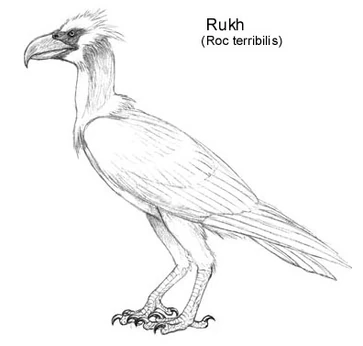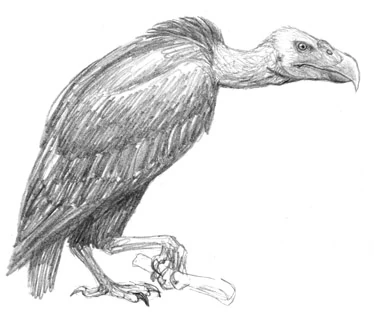INTRODUCTION
Another group of predatory paleognaths, in their way even more terrifying than the ferocious gobblers, are the giant rocs. Rocs are a group of large to enormous predatory birds that evolved from African paleognaths in the Paleogene. Their stork-like ancestors, much like the presumed progenitors of the diablorithiforms, seem to have eaten amphibians, small reptiles and mammals. At some point, one species specialized on eating the young of the early hoplocrocs, starting the evolutionary line leading to modern rocs. Today there are several roc species in Madagascar specialized in different kinds of prey from juvenile hoplocrocs to lemur-like mammals. Rocs have also spread to Africa, leading to some new forms.
Roc wingspans:
- Rukh: 5.5 meters.
- Lemur roc: 1.8 meters.
- Vulture roc: 3 meters.
- Rongo: 4 meters.
SPECIES (Rukh, Roc, and Rongos)
Rukh (Roc terriblis)
With a wingspan of 5.5 meters, the Rukh is the largest of the rociformes, and the largest living flying bird. It occurs primarily on the island continent of Madagascar, occurring as a vagrant in mainland Africa; subfossil remains also occur in India and the Caucasus, and it has been suggested that the malagasy population is a relic of an extinct Asiatic population. With it's massive bulk, it is Madagascar's second largest theropod predator, stalking the savannahs, scrub and multiple types of alpine grassland like a magnified version of HE's secretary bird. With it's powerful talons and long legs, it is capable of killing prey both on the ground and on the air, hunting everything from juvenile hoplocrocs to even large prey like sick sauropods and giant lemurs. Adult birds are fiercely territorial, maintaing well defended hunting grounds, while immature birds form gangs, often targeting larger prey; immature birds often otherwise remain with their parents for one or two years, helping to raise the younger generation, and aiding their parents in hunting. Sill, most of it's diet is composed of carrion, benefiting from the usual absence of gorgeese.
The rukh is the largest of the rociformids, with a wingspan of 5.5 m. It hunts young hoplocrocs both from the air and on the ground, but is also known to occasionally scavenge. Rukhs can also run rather fast thanks to their long legs, and often follow their prey on foot, if it manages to avoid the curved talons of the giant bird
Almost identical to an HE Gyps vulture - albeit with the typical roc caveats, such as a simpler rhamphoteca, the Vulture Roc is something of an enigma to specexplorers. It was assumed to have evolved in Madagascar, where the absence of gorgeese and harpies meant no competition for the supply of carcasses provided by the many island endemics. However, similar rocs have been found in both Eurasia and the Americas - the latter among the last american rocs, occurring in the La Brea pits as recently as 14,000 ago often in the company of gorgeese, harpies and/or scavenging pterosaurs. Suffice to say, how this niche partitioning worked, and why they disappeared after such success, is still a huge mystery.
Vulture Roc (Struthiogyps madagascarensis)
The living Vulture Roc is mostly restricted to Madagascar, though African vagrants are more common than with the other endemic roc species. Like the Lemur Roc, it too has largely shortened legs, though it's talons are very reduced and it's toes weaker, as typical for scavenging birds, though the toes are quite prehensile. With a wingspan of 3 meters, the Vulture Roc occurs primarily in the malagasy highlands, nesting in the inaccessible cliffs and mountain trees, though it frequently descends to the savannas to feed. It almost never kills living prey - aside from occasional ganging on sick animals -, relying on it's size and powerful beak to bully smaller predators and scavengers away.
Vulture Rocs are the most precocial of all rocs, with their juveniles leaving their parents after a month. Conversely, they're quite intelligent for roc standards, using their prehensile toes to grasp and play with objects they come across. The most social of all rocs, Vulture Rocs prefer to live in flocks, and it is thought that this facilitates knowledge exchange between birds, the whole of the flock transmitting more wisdoms than a single pair.
Ajundant Roc (Miasmornis tyrannophila)
The most unusual of all rocs, this bald, stork-like bird with a 3.5 meter wingspan wanders the open plains and scrub land of most of Africa and western Eurasian, from the Iberian Peninsula to India; extinct members of it's genus, which may or may not be of the same species, have been found in all over North America. Genetic samples have shown that it diverged from the other rocs perhaps as far back in time as the Early Miocene, and while certainly a fairly derived animal it still retains the basic feel of the ancestral roc, a crane like opportunist stalking the savannas. With longer legs than it's relatives and a beak that is simply a deeper version of the HE crane model, this bird is an agile runner, it's hallux not dexterous at all.
A resourceful predator, it will attack anything it is able to overpower, from fish to young dinosaurs and crocodiles. It is most easily seen at the site of a carcass; it is large enough to fend off most gorgeese with its long strong beak, and agile enough to sidestep hulky crunchercrocs and shaggy vulgures. It selects and swallows choice pieces of meat until it is too full to fly - luckily these animals are good runners even when gorged. Another prime time to spot these versatile feeders is during the breeding season of any animal that swims, walks, crawls or flies. It plucks helpless bird chicks from nests, in trees or on the ground; being among the largest birds on the savanna, only the dangerous cityfinches are safe from its plunderous beak. Other hatchling dinosaurs, crocs, and turtles are also on the menu, as long as the adjutant rocs can avoid protective parents. Huge dinopats left by animals like the grassbag often attract small to very large dung beetles as well as animals that prey on them. This often attracts adjundant rocs to take advantage of this dung-induced feast.
The birds themselves usually nest in a platform of branches in savannah trees, tall or not. The chicks leave the nest in a matter of a week, when they develop flight feathers. They follow the parents around in the savannah, picking insects and other small animals are they run around. They remain close to the parents for as much as 9 months, before setting off alone. Sexual maturity is reached at four years of age.
Adjundant Rocs often associate themselves with azhdarchids. Although these animals occupy similar ecological niches, agressive exchanges seem minimal, and at times their relationship seems commensal, as they often benefit from the startled prey fleeing each animal when foraging. Of course, either animal will more gladly than not attempt to devour each other's eggs and flaplings/chicks. Compared to azhdarchids, Adjundant Rocs are more solitary, though they generally tolerate other birds of the same species, especially when food is abundant.
Lemur Roc (Eumahery pithecophaga)
The smallest living roc is also among the most specialized. In spite of a meager wingspan of 1.8 meters, this bird is a more aggressive predator than the Rukh, being a specialized primate killer. Compared to other rocs, it's legs are shorter and more robust, and it's talons are larger and more powerful. As a forest predator, it's wings are also shorter and rounder. Overall, it resembles a roc version of a forest eagle, and behaves like one, hunting primarily arboreal lemurs. It is the apex predator of the malagasy forest canopy, and it bears more power on the montane forests, where the smaller diversity of terrestrial crocs allows it to hunt terrestrial prey as well, usually the many times of ground lemurs endemic to those areas. Depending on the prey's size, it may carry it away or simply feed on the spot, making it one of the most aggressive rocs. Always solitary, it defends large territories from even other predators, killing nesodelphian mammals and arboreal baurusuchids whenever possible. The young are more dependent on their parents than other rocs, only becoming airborne at about one month of age, and staying with the parents for over an year.
Rongo (Roc africanus)
Closely related to the Rukh, the Rongo occurs in mainland Africa, having diverged from it's Indo-Malagasy relative in the early Pleistocene. Slightly smaller at a meter wingspan, the Rongo is a more cryptic animal, preffering wetland biomes. While it is still an equally opportunist feeder, the Rongo has a preference for fish, cathcing them from the air like the fishing avisaurs it often co-exists with, or stealing them from smaller piscivores. Due to the seasonal nature of African wetlands, the Rongo tends also to be more migratory or nomadic, rarely forming fixed hunting grounds, and thus being generally more gregarious. In both roc species, sexual maturity is reached at six years of age.
ROCIFORMES=Roc terribilis (Rukh)



